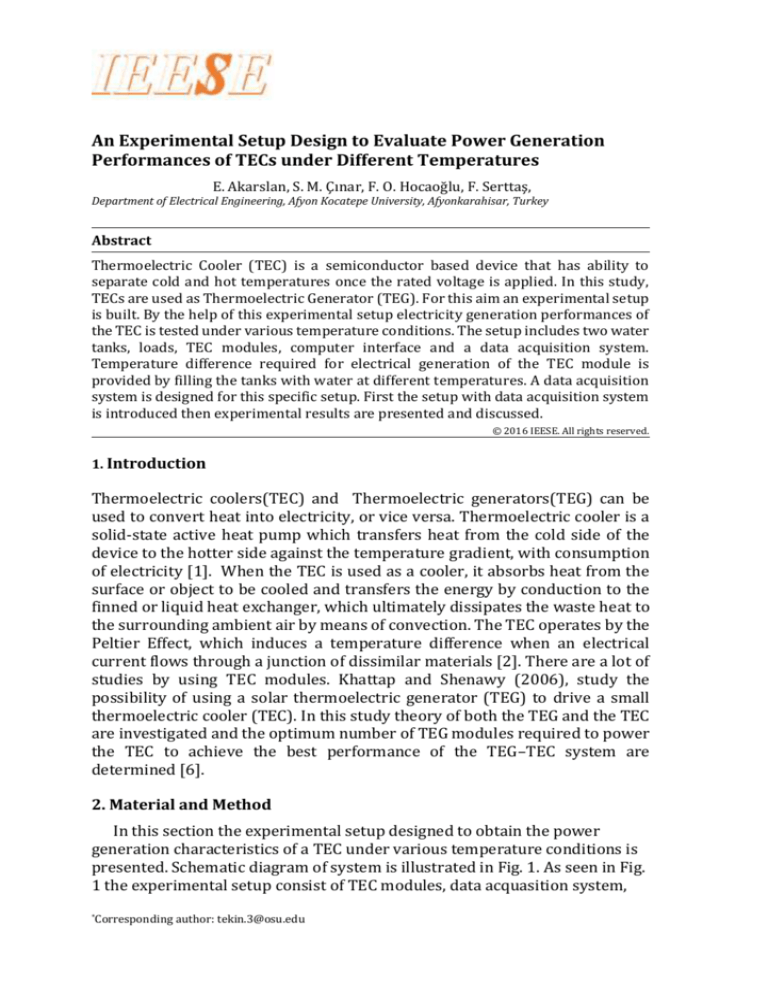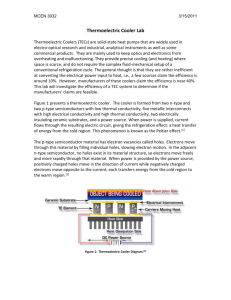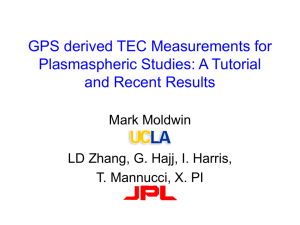
An Experimental Setup Design to Evaluate Power Generation
Performances of TECs under Different Temperatures
E. Akarslan, S. M. Çınar, F. O. Hocaoğlu, F. Serttaş,
Department of Electrical Engineering, Afyon Kocatepe University, Afyonkarahisar, Turkey
Abstract
Thermoelectric Cooler (TEC) is a semiconductor based device that has ability to
separate cold and hot temperatures once the rated voltage is applied. In this study,
TECs are used as Thermoelectric Generator (TEG). For this aim an experimental setup
is built. By the help of this experimental setup electricity generation performances of
the TEC is tested under various temperature conditions. The setup includes two water
tanks, loads, TEC modules, computer interface and a data acquisition system.
Temperature difference required for electrical generation of the TEC module is
provided by filling the tanks with water at different temperatures. A data acquisition
system is designed for this specific setup. First the setup with data acquisition system
is introduced then experimental results are presented and discussed.
© 2016 IEESE. All rights reserved.
1. Introduction
Thermoelectric coolers(TEC) and Thermoelectric generators(TEG) can be
used to convert heat into electricity, or vice versa. Thermoelectric cooler is a
solid-state active heat pump which transfers heat from the cold side of the
device to the hotter side against the temperature gradient, with consumption
of electricity [1]. When the TEC is used as a cooler, it absorbs heat from the
surface or object to be cooled and transfers the energy by conduction to the
finned or liquid heat exchanger, which ultimately dissipates the waste heat to
the surrounding ambient air by means of convection. The TEC operates by the
Peltier Effect, which induces a temperature difference when an electrical
current flows through a junction of dissimilar materials [2]. There are a lot of
studies by using TEC modules. Khattap and Shenawy (2006), study the
possibility of using a solar thermoelectric generator (TEG) to drive a small
thermoelectric cooler (TEC). In this study theory of both the TEG and the TEC
are investigated and the optimum number of TEG modules required to power
the TEC to achieve the best performance of the TEG–TEC system are
determined [6].
2. Material and Method
In this section the experimental setup designed to obtain the power
generation characteristics of a TEC under various temperature conditions is
presented. Schematic diagram of system is illustrated in Fig. 1. As seen in Fig.
1 the experimental setup consist of TEC modules, data acquasition system,
*Corresponding
author: tekin.3@osu.edu
Akarslan et al. / 8th International Ege Energy Symposium and Exhibition - 2016
two water tanks, loads and computer interface. Two TEC modules connected
in a serial hierarchy are employed as power generators. Hot and cold water
tanks are located two sides of module to provide temperature difference.
Three LM-35 sensors employed to measure temperature in cold and hot
water tanks and ambient. Electricity generations of the TEC modules are
calculated with measured current and voltage on load. A data acquisition
board is designed to collect data from sensors. The system has ability to
transfer the collected data to a computer via serial port. Computer interface
is developed in LabVIEW envorinment. By the help of this data collection
system, temperatures measured from hot water tank, cold water tank and
ambient temperatures, current and voltage of TEC module data can observed
and collected.
2.1. Thermoelectric Cooler (TEC)
Thermoelectric cooler (TEC) is a solid state electrically driven heat exchanger
that can pump heat in a direction depending on the polarity of the applied
voltage. The TEC operates by the Peltier Effect, which induces a temperature
difference when an electrical current flows through a junction of dissimilar
materials [2]. The TEC element includes a pair of p- and n-type semiconductor
columns, three metallic connectors, and two electrically insulating ceramic
plates. By the current flows from the p-type to n-type semiconductor, the holes
in the p-type semiconductor and the electrons in the n-type semiconductor
migrate from the cold end to the hot end, the corresponding Peltier heats will
be generated at the interface between connectors and semiconductors [3]. The
actual ΔT is defined as the temperature difference between the hot side
temperature (Th) and the cold side temperature (Tc) of the TEC device.
Fig.1. Schematic diagram of setup
2.1.1 Modelling Procedure
Throughout this study, FEM (Deform 3D) is used as a tool to determine
required shear force to shear a specific drill pipe and evaluate the effect of
2
Akarslan et al. / 8th International Ege Energy Symposium and Exhibition - 2016
weight of drill string on the shearing operation. Drill pipe dimensions and
properties were given in Table 1.
Table 1 Drill pipe dimensions and properties [4]
Weight
Yield
/
Thickne Area
strengt
# Material
length
h
O.D.
I.D. ss (mm) (cm2) ratio
(MPa)
(mm) (mm)
(kg/m)
11
1014.2
S-135 5” (127) 108.61 9.195 34.03 29.02
0
2
13
5.5”
1052.8
S-135
121.30 9.169 37.60 32.59
5
(139.7)
3
Dimensions
Ultimate
tensile Elon
strength g %
(MPa)
1099.71 23.1
1101.78 20.0
Since the original flow stress curve of materials was not available, it was
approximated by using the Eq (1):
(1)
𝑌𝑓 = 𝐾𝜀 𝑛
where, Yf: Flow stress, ε: True strain, K: Strength coefficient, n: Strain
hardening exponent [10]…
A finite element model is developed to represent a cracked beam element of
length d and the crack is located at a distance d1 from the left end of the
element as shown in Figs. 2-3. Substituting Eqs. (3)-(4) in Eq. (7) yields the….
3. Experimental Setup
In this study two termoelectric coolers are connected in a serial hierarchy.
TEC1-12706 model thermoelectric coolers are used and temperature
difference is provided by the water tanks which are located to two sides of
TEC. Hot and cold water tanks filled water 90 0C and 20 0C, respectively. A 22
ohm resistance is employed as a load and current and voltage values are
measured on this load. The experimental setup used in this study is shown in
Fig. 5. Data acquasition system stars to collect the data once the water tanks
are filled. Experiments are concluded in 80 minutes. Temperatures versus
time are presented in Fig
4. Results and Discussions
After the filling water tanks with the hot and cold water, a temperature
difference is observed. This difference decreases by the time due to thermal
conductuvity. Therefore voltage and current values generated by the TECs are
decreased. Electricity generations of the TECs are decreased since the current
3
Akarslan et al. / 8th International Ege Energy Symposium and Exhibition - 2016
and voltages are decreased. Graphics of temperature difference and generated
power are shown in Fig. 2. It is obvious that, if the temperature difference
between the two side of TEC can kept high, TECs generate much more
electricity.
80
70
Temperature difference [C]
60
50
40
30
20
10
0
0
50
100
150
200
250
Time [x10s]
300
350
400
450
500
Fig. 2. Temperature change versus time graphic
5. Conclussion
In this study an experimental setup is designed to test the performences of
TECs in case they are employed as TEGs. A data acquisition system is
developed for this special setup. The system consist of temperature sensors, a
microcontroller based data acquisition system, liquid tanks and loads.
Thermal difference is supplied with water in different temperatures. It is
observed that by increasing the difference between the temperatures of the
waters in liquid tanks the total generation from the TEG increases. Using this
simple experimental setup it is possible to determine the characteristics of
different TECs in case they are employed as TEGs. Furthermore different
liquids can be tested as heat transfer tool. The system can be used as a pretest
equipment of a special energy generation system that generates electricty
from wate heats and heat differencies. [1][2][3][4]
References
[1]
E. Akarslan and F. O. Hocaoglu, “A novel adaptive approach for hourly
solar radiation forecasting,” Renew. Energy, vol. 87, pp. 628–633, Mar.
2016.
[2]
F. O. Hocaoğlu, “Novel analytical hourly solar radiation models for
photovoltaic based system sizing algorithms,” Energy Convers. Manag.,
2
Akarslan et al. / 8th International Ege Energy Symposium and Exhibition - 2016
vol. 51, no. 12, pp. 2921–2929, Dec. 2010.
[3]
E. Akarslan, F. O. Hocaoğlu, and R. Edizkan, “A novel M-D (multidimensional) linear prediction filter approach for hourly solar
radiation forecasting,” Energy, vol. 73, pp. 978–986, Aug. 2014.
[4]
E. Akarslan, S. M. Çınar, F. O. Hocaoğlu, and F. Serttaş, “An
Experimental Setup Design to Evaluate Power Generation
Performances of TECs under Different Temperatures,” Appl. Mech.
Mater., vol. 492, pp. 473–477, Jan. 2014.
3











